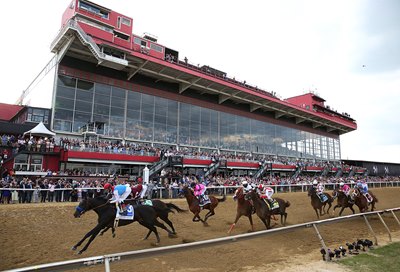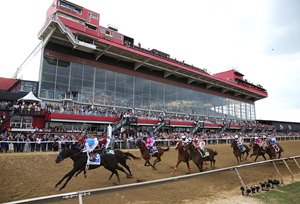One-Track Plan Looms More and More Likely in Maryland


About three years ago there was joy and a deep sense of relief for the Thoroughbred industry in Maryland when the State Legislature passed a bill that called for $375 million in bonds to rebuild the crumbling Maryland Jockey Club facilities at Pimlico Race Course and Laurel Park.
It was a moment in time when the industry looked past years of missteps and legal battles to embrace a bright future with two modern facilities and a proper home for Pimlico's Preakness Stakes (G1), the famed second jewel in the Triple Crown.
"This is truly a defining moment in the history of the Maryland Thoroughbred racing industry and the state," Alan Rifkin, counsel for the Maryland Jockey Club (an arm of 1/ST Racing) and Preakness Stakes, said at the time.
Now that moment is gone.
The death knell for those ambitious plans sounded April 10 when Maryland lawmakers overwhelmingly passed a bill creating the Maryland Thoroughbred Racetrack Operating Authority to work with the stakeholders to eliminate numerous bottlenecks and produce a new vision for the industry by Dec. 1.

"This was the logical next step. This is what was needed to be done," said Alan Foreman, counsel for the Maryland Thoroughbred Horsemen's Association. "There was great frustration at the end of last year's legislative session. The project was way behind and way over budget."
While control of the project has now shifted from the Maryland Stadium Authority to the MTROA, the change involves more than acronyms. It comes amidst a new reality for Maryland racing in which having two new racing facilities is a longshot and the most viable option is to consolidate racing at a renovated Pimlico and create a training center—possibly at Laurel—to accommodate the horse population.
"It's more likely than ever that Pimlico will become the hub of Maryland racing," Foreman said about the 153-year-old facility in Baltimore where deterioration led to the closing of a section of the grandstand in 2019. "When the stadium authority realized the cost of rebuilding Laurel was prohibitive, we started looking at the consequences that there may not be a Laurel in the future of Maryland racing and we may have to consolidate at Pimlico and build a training center at Laurel. We might also need a new site for a training center if rebuilding Laurel is not found to be a feasible project."
What's happening now is the latest frustrating chapter in a book that many believe begins in 2009 when The Stronach Group (1/ST Racing's corporate name at the time) failed to pay a required license deposit on time and its MJC lost all hope of bringing gaming to Laurel. Without the alternative revenue stream that surrounding states possess, Maryland's tracks missed out on the best possible deal to make ends meet.
"What we have now is the accident that was waiting to happen when the Stronach Group did not get involved in gaming more than 10 years ago," Foreman said.
While the 2020 legislation was supposed to solve the problem, its inability to get started paints a stark picture for the possibility of rebuilding two racetracks. What doomed the previous legislation was a combination of COVID-19, inflation, increased labor and material costs, and an expensive tax issue for the MJC. Simply put, what was considered a $375 million project in 2020, now has a price tag of about $600 million. At the same time, the 2020 bonds are worth about $250 million now because of changes in interest rates, creating a shortfall that the MSA could not plug.
Under the new legislation, Bill Cole, a lead negotiator for the City of Baltimore in the process, says about $400 million-$410 million will be available. Yet that still leaves a deficit of about $200 million.
While stakeholder representatives all stress that nothing has been decided yet, and that all options are still on the table, there's no getting around the fact that a massive amount of additional money will be needed if the plan remains to rejuvenate both tracks. No one, especially the state or the MJC, appears interested in providing that cash.
"We have a finite budget. That is clear," Cole said. "The legislature has no appetite for adding more money and we've been told the budget approved several years ago is our budget now. We are working under the assumption that we must live within our means."

That scenario would seem to make rebuilding one track the best option, and since saving Pimlico and keeping the Preakness in Baltimore was the spark that led to the 2020 legislation, it seems likely that Pimlico would get the nod over Laurel on any one-track plan.
"We've heard very clearly that Pimlico remains the main focus and I don't see any way Pimlico is not protected and preserved," Cole said.
The need for a new redevelopment plan also casts some amount of doubt on 1/ST Racing's future in Maryland. At the moment the MJC owns both Pimlico and Laurel, but as part of the 2020 deal, it agreed to turn Pimlico over to public control by the city and state while retaining ownership of Laurel, which also needs significant improvements.
"Laurel needs to be rebuilt. It is in worse shape than Pimlico," Foreman said. "You can gussy up the grandstand, but the fact of the matter is that there are structural problems with the building. There are all kinds of issues with the backstretch, water issues, problems with the racing surface. The dirt course has to be replaced. All of that was obvious when the (MSA) studied it."
Having the state pay for the redevelopment of Laurel sounded like a great deal for the MJC, until it became known that Maryland law stipulates that when public funds are used for a private entity, the owner becomes liable for capital gains taxes. In the case of the MJC that tax bill could be somewhere between $10 million-$40 million depending on the scope of the project. When faced with that prospect, the MJC understandably applied the brakes to moving forward on the plan while an answer to that roadblock could found. So far, no one has offered one and since it's a state law, there's little to no wiggle room around it.

With that tax issue hovering overhead, insiders wonder if MJC and 1/ST Racing would possibly move to the role of track operator without an ownership stake?
Asked about that possibility, Rifkin said, "It would be premature for me to comment on any one particular permutation. What I can say is: TSG/MJC continues to discuss in good faith and in the best interests of Maryland's historic racing industry all reasonable ideas and operational structures that could ensure the long-term viability, profitability, and sustainability of all stakeholders."
Adding to questions about the future of 1/ST Racing in Maryland, the MTROA has the power to bring in a new operator. Foreman said a provision of Maryland law allows the state to seize ownership of the tracks and work out fair compensation for the former owner.
"We might need a more flexible operating model in Maryland," Cole said.
However, finding an entity willing to be merely an operator, be it the MJC or another group, could be another in a series of problematic issues facing the MTROA.
"State law includes the ability to step in and essentially take over and find a new operator if needed," Foreman said, "but I don't know who would be interested in doing that without the gaming component. As part of the process, we have been looking at all the operating models, such as Del Mar, (the New York Racing Association), New Jersey, in the event we have to face that possibility if needed. We began hiring experts to look at operations and they filed a report Sept. 30. It indicated that Del Mar is most aligned with Maryland's interests going forward. Del Mar is owned by the state and there is an authority that has control and oversees the property. And then there is the Del Mar Thoroughbred Club which is the operating entity. They are tax-exempt and that's the kind of the model we would be looking at."
Without a plan in place at the moment, tensions have been rising. Compounding the situation, there have been costly issues with the facilities, such as problems with the racing surface conditions at Laurel, a lingering problem that forced the cancellation of racing April 8.
Foreman said that when a 10-year agreement between the horsemen, breeders, and the MJC ended late last year, a new agreement could not be reached among the MJC, MTHA, and the Maryland Horse Breeders' Association. Instead, a six-month extension for continued negotiations was agreed upon. The 10-year agreement had guaranteed 100 racing days and created a "revenue-sharing" contract with the horsemen for additional dates.
"Our assumption was the 10-year agreement would be extended, but in November the (MJC, 1/ST Racing) came in and said that unless the horsemen are willing to pay substantially more money than they are currently paying, because of (MJC's) losses, they would not extend the agreement," Foreman said.
It's surely a complex and frustrating situation facing the Maryland racing industry with no simple answers, but those closely involved in the process are optimistic that there's still a fervent desire among the stakeholders to find solutions and structures that will ultimately brighten the sport's future in the Old Line State.
"We still have a lot of work to do with the MJC and the horsemen," Cole said, "but I believe there's the common goal of preserving Maryland racing. We have a finite amount of time to come up with a global solution but we have a mutual interest in coming up with a solution."
